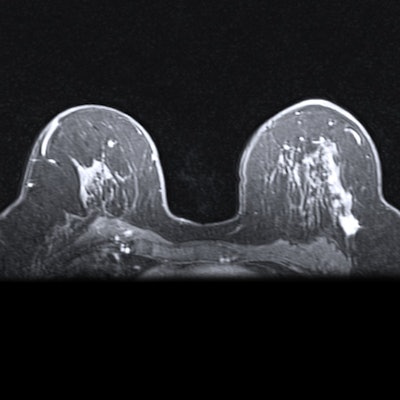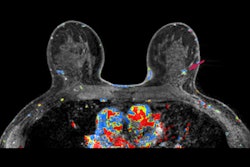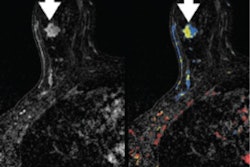
Nearly twice as many breast MRI scans are initially interpreted as being positive for cancer in women who have higher background parenchymal enhancement (BPE), according to a study published online July 18 in Academic Radiology. But cancer detection rate, sensitivity, and specificity don't appear to be affected in these women.
The study results could have implications for patient care, wrote a team led by Dr. Dorothy Sippo of Massachusetts General Hospital in Boston.
"Normal BPE can have many patterns. When it is asymmetric, focal, or regional, it can be difficult to distinguish from a suspicious lesion," the group wrote. "Still, every effort should be made to distinguish normal BPE variations from truly abnormal findings."
MRI is a sensitive screening test for detecting breast cancer in women at high risk for the disease, and the number of breast MRI exams is increasing, Sippo and colleagues noted. But the modality has its limitations, particularly in differentiating suspicious lesions from BPE, according to the group.
"There has been speculation that higher levels of BPE may negatively impact the diagnostic performance of MRI, analogous to breast density's impact on mammography," the authors wrote. "If this analogy is accurate, then the attention paid to mammographic breast density emphasizes the importance of studying BPE in the MRI screening setting."
Sippo's team conducted a study that included 4,686 screening breast MRIs performed in 2,446 women between 2011 and 2014. The researchers gathered data on the women's BPE from radiology reports and categorized it as lower (minimal or mild) or higher (moderate or marked); of the total screening MRIs, BPE was minimal or mild for 85% and moderate or marked for 15%. The team then compared the two cohorts, adjusting for age, screening indication, mammographic density, available prior breast MRI, and exam year. The group of women with lower BPE was considered the reference.
In all, 73 cancers were detected among the study participants; most of these were found in women with lower BPE (77%) compared with those with higher BPE (23%). An interpretation was considered "positive" for cancer if given a BI-RADS rating of 0, 3, 4, or 5, and "negative" if given a BI-RADS rating of 1 or 2. The abnormal interpretation rate was calculated as the number of positive exams divided by the total number of exams to determine how many patients had breast MRI scans initially considered positive for cancer.
The authors found that the abnormal interpretation rate among women with higher BPE was almost twice that among women with lower BPE, at 13% compared with 7% (p = < 0.01).
The group also found the following:
- Of the study participants, 67% had dense breast tissue.
- The most common indication for screening MRI was personal history of breast cancer (54%), followed by family history (26%).
- Women with higher levels of BPE were younger, had dense breasts, and were more likely to have family history of breast cancer rather than a personal history.
The study findings suggest that more education may be needed to teach physicians about the characteristics of normal BPE, according to Sippo and colleagues.
"Future efforts such as education and advanced MRI techniques may help to distinguish BPE from suspicious lesions and minimize false-positive examinations," the researchers concluded.



















